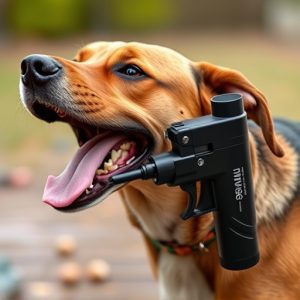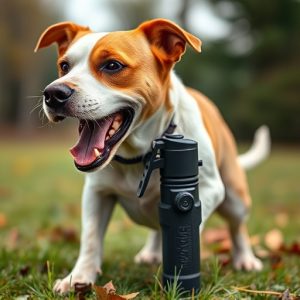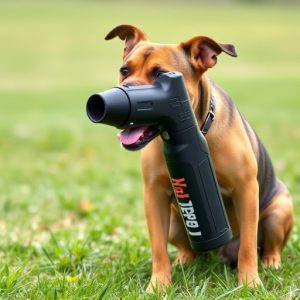Formulating Safe Dog Deterrent Spray: Effectiveness and Responsible Use
Dog deterrent sprays' effectiveness stems from capsaicin, a chili pepper compound causing a bur…….
Dog deterrent sprays' effectiveness stems from capsaicin, a chili pepper compound causing a burning sensation. 'Safe' pepper spray strength for dogs refers to diluted capsaicin formulations designed to deter without harm. Proper use according to manufacturer guidelines is vital to prevent discomfort or adverse reactions.
Discover the power of dog deterrent spray—a safe and effective solution for managing canine behavior. In this comprehensive guide, we explore why such sprays are essential tools for pet owners and professionals alike. From understanding the science behind capsaicin’s impact on dogs to crafting the perfect formula, we delve into the key components for a strong yet safe pepper spray designed specifically for them. Learn optimal application techniques and navigate legal considerations for responsible use.
- Understanding Dog Deterrent Spray: Why It's Necessary
- The Science Behind Capsaicin and Its Effect on Dogs
- Formulating a Safe and Effective Dog Deterrent Spray
- Application Techniques for Optimal Results
- Legal Considerations and Responsible Use Guidelines
Understanding Dog Deterrent Spray: Why It's Necessary
Dog deterrent spray is a crucial tool for maintaining control and safety in situations where dogs may pose a threat. Understanding its necessity is key to effective use and ensuring both animal welfare and public safety. Typically formulated with capsaicin, the active ingredient found in chili peppers, these sprays create an unpleasant sensory experience for dogs, temporarily deterring them from unwanted behaviors or areas.
Choosing the right formula is essential, balancing effectiveness and safety. The ideal dog deterrent spray should offer a safe pepper spray strength tailored for canine use without causing severe harm or long-lasting effects. This gentle yet powerful approach ensures that dogs are deterred while minimizing risks associated with more aggressive chemical compounds.
The Science Behind Capsaicin and Its Effect on Dogs
The active ingredient in many dog deterrent sprays is capsaicin, a compound found in chili peppers that gives them their heat. When sprayed onto a dog’s fur or skin, capsaicin triggers a sensation of burning and irritation, designed to startle and deter the animal without causing serious harm. This reaction is based on science: dogs have sensory receptors similar to those in human mouths, which detect capsaicin and send signals to the brain, triggering a defensive response.
The ‘safe’ pepper spray strength for dogs refers to formulations that contain capsaicin in concentrations tailored to be effective yet non-toxic. While pure capsaicin is highly potent, commercial dog deterrents often use diluted forms, ensuring they are safe for pets and people when used correctly. The key lies in understanding the appropriate application and usage guidelines provided by manufacturers, as even a ‘safe’ spray can cause discomfort if misused.
Formulating a Safe and Effective Dog Deterrent Spray
When formulating a dog deterrent spray, safety and effectiveness should be the top priorities. The key is to strike a balance between creating a repellant that discourages dogs from approaching and ensuring it’s safe for both pets and humans. Traditional pepper sprays, known for their potent effects on humans, can be too harsh and potentially dangerous when used on dogs. Instead, opt for dog-specific deterrents that utilize natural ingredients or carefully selected chemicals with low toxicity levels.
The ideal formula should have a controlled strength of capsaicin, the active ingredient in chili peppers responsible for the burning sensation. While a strong concentration can be effective, it’s crucial to keep it within a safe range, typically below 10% to avoid causing severe discomfort or health issues. Additionally, incorporating water as the base diluent helps reduce the spray’s strength and makes it easier to rinse off fur and skin. Other beneficial additives include natural essential oils like citronella or peppermint, which have been shown to repel dogs without leaving harmful residues.
Application Techniques for Optimal Results
When using a dog deterrent spray, understanding application techniques is key to achieving optimal results. Start by identifying the areas where your dog tends to show unwanted behavior, such as entry points or specific spots in your yard. Spraying directly on these problem areas ensures maximum coverage and effectiveness. It’s important to use a safe pepper spray designed specifically for dogs, with a strength that’s suitable for their sensitive noses without causing severe harm. This balance is crucial, as too strong a solution might cause panic or even injury.
For best results, apply the spray consistently, reinforcing positive behavior through reinforcement training. Regular application can help deter your dog from recurring unwanted actions. Remember to store the spray out of reach and follow safety guidelines strictly. Always test the spray in a controlled environment first to ensure it’s well-tolerated by both your dog and any other animals or humans present.
Legal Considerations and Responsible Use Guidelines
When considering using a dog deterrent spray, it’s crucial to understand legal considerations and responsible use guidelines. The safe pepper spray strength for dogs varies by region; what is permitted in one area may be illegal in another. It’s essential to check local laws and regulations before purchasing or using any type of dog deterrent. Some jurisdictions have strict restrictions on the concentration of capsaicin, the active ingredient in pepper spray, and the methods of application allowed.
Responsible use involves adhering to manufacturer instructions and ensuring the safety of both your dog and any humans or animals nearby. Only use deterrents when necessary, as overuse can desensitize dogs to the scent over time. Always keep such sprays out of reach of children and pets, and store them in a secure location. Additionally, be mindful of weather conditions; wind or rain could affect the spray’s effectiveness or cause it to blow back onto you or your dog.


